
Scott Oliver speaks to Australia great Mark Waugh and his former Egerton CC teammates about his summer in club cricket.
Subscribe to the Wisden Cricket YouTube channel for post-match awards, player interviews, analysis and much more.
Heading into the 1985 season, it would be fair to say that Egerton CC – founder members of the Bolton League (BCL) yet without a league title in 55 years of trying – were pretty happy with their recruitment. They had contacted stalwart Lancashire off-spinner ‘Flat’ Jack Simmons, seeking a replacement for the previous year’s pro: a 21-year-old Salim Malik, who was already a veteran of 16 Tests during a truncated season at Longworth Road that yielded 702 runs at 54 with a best of 152 not out.
BCL rules permitted both an overseas pro and overseas amateur, and Simmons had come back with two options for the paid role: 20-year-old Victorian batsman Jamie Siddons or a promising 19-year-old all-rounder from New South Wales who had just made 71 at number eight in a one-wicket Sheffield Shield final victory against Queensland. In the end, the sage committee men of Egerton took the second option, Stephen Rodger Waugh, swayed by his bowling ability and the fact that the package included an overseas amateur of a similar age who Waugh knew very well from the NSW set-up and as a teammate at Bankstown in Sydney Grade cricket. His twin brother, Mark.
The pair arrived in early April – Steve eight months from a Test debut, Mark still almost six years from the first of his 128 Test caps – and were billeted in the Bradshaw home of Peter and Iris Greenhalgh, a couple of miles down the road from the village of Egerton. “I think they answered an ad in the local paper,” recalls ‘Junior’ Waugh. “Their daughter, Karen, went out with a guy called Billy who played for Farnworth. They were beautiful people who treated myself and Stephen like we were their sons. We were spoilt rotten: no washing, no cooking, everything taken care of. They looked after us better than could be expected to be honest.”
Although the teenage twins were still greenhorns – Mark was yet to make his first-class debut – there was cautious optimism at Egerton that they might be able to challenge the league’s big guns, recalls opening batsman Dave Sumner. “I remember Rod Tucker, now an ICC umpire, who was pro at Farnworth, saying: ‘Well that’s it, job done. Egerton will win the league with those two.’ That was before we’d bowled a ball.”
A week prior to the start of the league campaign, Egerton played a pre-season friendly at Atherton – a name the twins would grow accustomed to inflicting pain upon – of the neighbouring (or overlapping) Bolton Cricket Association, the league from which the fourteen clubs of the BCL had split in 1930. It was a chance for the squad to get to know their new overseas players, to have a hit and a bowl, get the cobwebs out of their systems. Opening the batting in icy April conditions, Mark made a measured 120, while Steve, at first drop, added a more destructive 90 not out. The brothers then shared all ten Atherton wickets. Big dreams started to form. Alas, it was the only game they would play together for the club, as forces far beyond the West Pennine moors snuffed out Egerton’s season of total Waugh before it ever really got going.
The day after the brothers had stepped off a gruelling 30-hour, economy-class flight to the UK, a lawyer representing Kerry Packer – owner of the domestic broadcast rights for Australia’s Test and ODI cricket – knocked on the Greenhalghs’ door with a three-year contract for Steve to sign, the fall-out from the Australian Cricket Board’s discovery that seven of the 17-man party they had selected for the upcoming Ashes trip had already signed up for the rebel tour to South Africa that November. Murray Bennett changed his mind, while Graeme Wood, Wayne Phillips and Dirk Wellham were offered inducements by Packer to reverse their decision, which they did, although it required an emergency meeting of Allan Border’s squad to welcome them back, having initially refused. Terry Alderman, Steve Rixon and Rod McCurdy remained steadfast in their off-piste commitments, however, and were duly replaced by Carl Rackemann, Ray Phillips and John Maguire. It then emerged that Rackemann and Maguire had signed up for the South Africa trip as well, so Jeff Thomson and Dave Gilbert were called up instead.
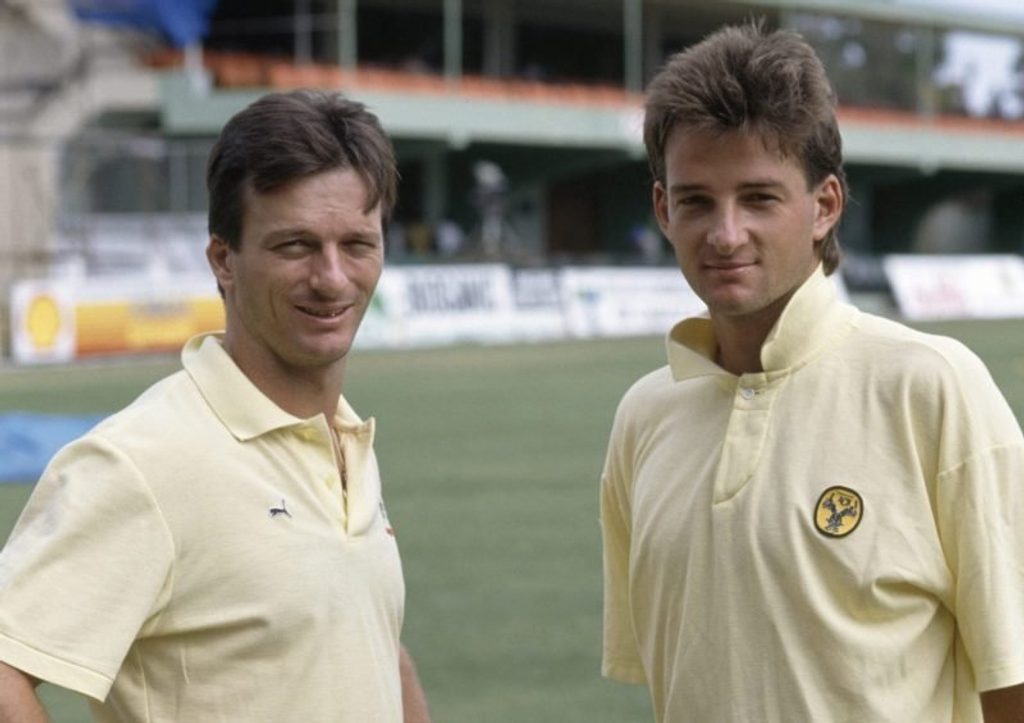 Steve and Mark Waugh in 1991
Steve and Mark Waugh in 1991
Gilbert was that year’s recipient of the ACB’s Esso Scholarship, and had been slated for a year with Essex Second XI. When he was drafted into the Ashes party, Steve Waugh was sent to Essex to replace him, spending the summer playing for the county’s reserves and club cricket for Chingford, but not before putting ink to Packer’s contract, confirming he would not be going to South Africa. “I’m thinking, what are you talking about? I don’t want to go on the rebel tour, I just want to play for Australia,” Waugh later told Australian Financial Review. “She just said, ‘Here’s the contract. Can you sign it?’ I looked at it. I’d never seen a contract before. I said, ‘What’s the catch?’ She said, ‘No catch, just commit to playing for Australia and you get $15,000 a year for each of the next three years.’ I said, ‘Where’s the pen?’ I’d had $100 in the bank in Australia when I left. It was no decision.”
All of which goes to show that, of all the consequences of Apartheid, many of them grotesque, one of the least well know is how a Lancashire village of around a thousand people were denied a summer of watching SR and ME Waugh get stuck into the local bowling. They would have to wait for later Ashes series for that.
The upshot of Steve’s departure was that Mark was promoted to pro – “Stephen and I were going to split the pro money anyway,” he says – while Egerton engaged the 21-year-old Western Australia opener Mark McPhee as overseas amateur. McPhee – who would perish in a car crash in 1999 at the age of 35 – was coming off a debut Sheffield Shield campaign in which he averaged 44.36, including what would remain his career best score of 135 against South Australia at the WACA.
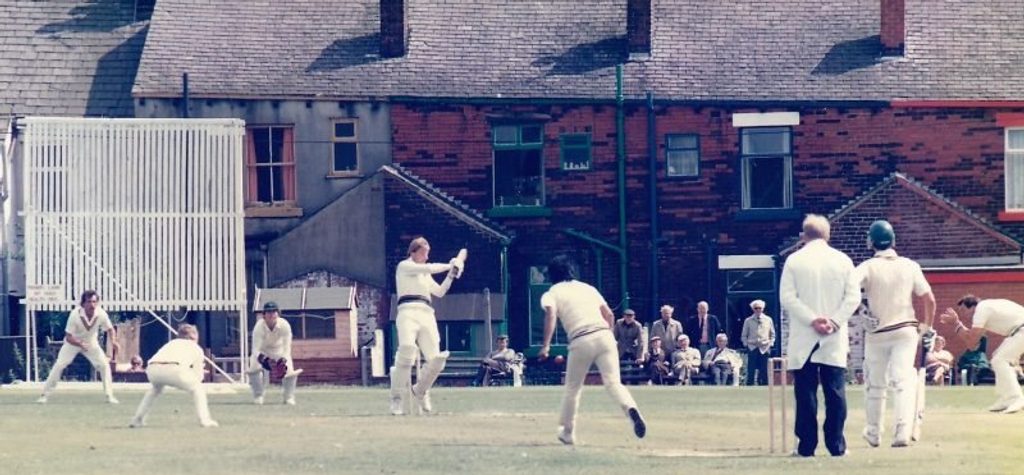 Mark Waugh pulls Tonge’s Chetan Sharma with Warren Hegg keeping (Credit: Mike Latham)
Mark Waugh pulls Tonge’s Chetan Sharma with Warren Hegg keeping (Credit: Mike Latham)
A gregarious soul who contributed 666 runs at 33.3 for Egerton, ‘Jock’ McPhee lodged with first team captain, Pete Moss, a dentist who had promised Mark Waugh a new set of crowns for his teeth if he passed 1000 runs. Not that this offer necessarily protected the skipper from his young Aussie’s exuberance, recalls Steve Dickinson, a youngster of 14 at the time whose father, Ken, batted number 11 and bowled left-arm spin for the first team. “Pete Moss came into bat in a practise session in this silver metal helmet. This was before helmets had really come out. Mark just said, ‘I’m going to knock his head off here, lads.’ He bowled him a bouncer and dented the side of this lid. Pete proper lost it and stomped off.”
The precise ins and outs of ‘Junior’ Waugh’s Bolton League season may have fallen victim to the pre-digital perils of a lost scorebook, but the broad contours and a smattering of detail have survived the fall into cultural oblivion. First off, having been promoted to pro, he began with a duck at Heaton – in whose second team that day lined up a 14-year-old Ronnie Irani, later to become good friends with Waugh at Essex – although he would take a century off them in the return game (as would McPhee), one of five he churned out that summer, alongside seven half-centuries. Keen mathematicians will note that this alone edges Waugh quite close to free dentistry.
The BCL handbook’s ‘Review of the Year’ from 1985 reports – over and above the penmanship news that “off the field, Eagley’s Geoff Cleworth took his twelfth scorebook award” – that the “year will be largely remembered for its distinct lack of temperature, no lack of rain, and postponements galore!” None of which would have made batting any easier at Egerton, sitting as it did on a considerable incline that funnelled water down to the square and created the ideal environment for that hardy species of club cricketer, dobberus parsimonia. “I remember the ground clearly,” says Waugh wistfully, “it had such a big slope. It was like there were two tiers on it.”
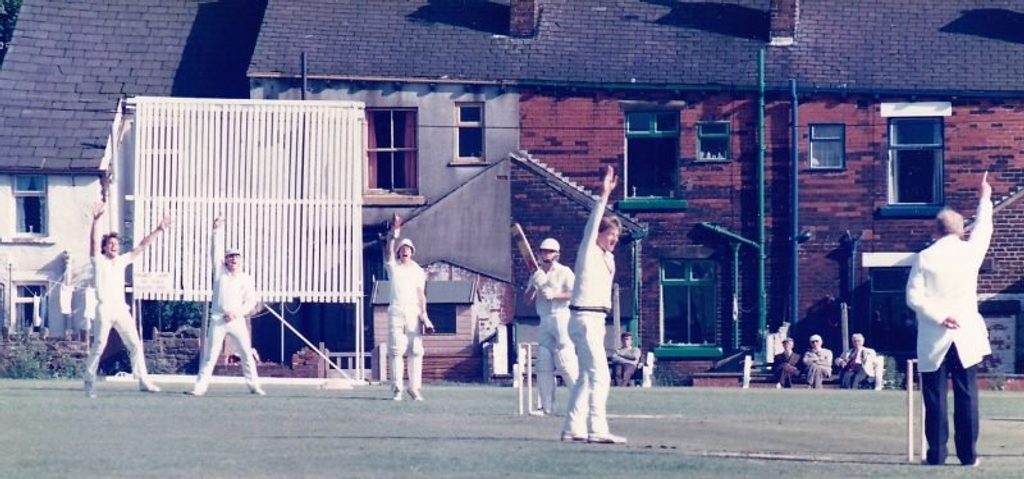 Tonges Nigel Partington lbw Mark Waugh 9 (Credit: Mike Latham)
Tonges Nigel Partington lbw Mark Waugh 9 (Credit: Mike Latham)
Waugh quickly worked out what to do with the 63mph accuracy merchants and their keeper-up, ring-field, asphyxiation devices, says Ian ‘Taddy’ Taylor, Egerton’s tearaway opening bowler: “He treated the dibbly-dobblers like spinners. He just used his feet to them and hit them over the top.” Not that he underestimated them, or didn’t do it all with an element of professional calculation.
“Early season, he would just hit it in the ‘V’ for the first ten or fifteen overs,” says Steve Dickinson. “A few of us were thinking, ‘Flippin’ ‘eck, get on with it, you boring sod,’ you know? ‘It’s club cricket, this.’ But then he would just go into overdrive and was absolute class. He could hit a ball wherever he wanted. It’s a large ground, Egerton, and there’s some poplar trees at the bottom of it. He hit a six one day and may God strike me dead, it was still going up when it went over the poplars.”
Of course, barracking slow-scoring ‘boring sods’ or otherwise underperforming pros was not something the avid watchers of Lancashire’s hard-bitten club cricket ever felt unduly sheepish about. Ten penn’orths were frequently and vociferously proffered, as Westhoughton’s professional that year – already a veteran of 76 Tests and a future world number one-ranked batsman, Dilip Vengsarkar – soon discovered after making three noughts in succession. Being the birthplace of former Manchester City and England midfielder and later toilet roll tycoon, Franny Lee, in whose factory a young Peter Kay had worked, Westhoughton wasn’t short of wisecrackers. “As getten a pen, lad?” asked one old wag of the Indian star, who, flummoxed, patted his pockets for a writing implement. “Nah, lad: a pen. To keep thee ducks in.”
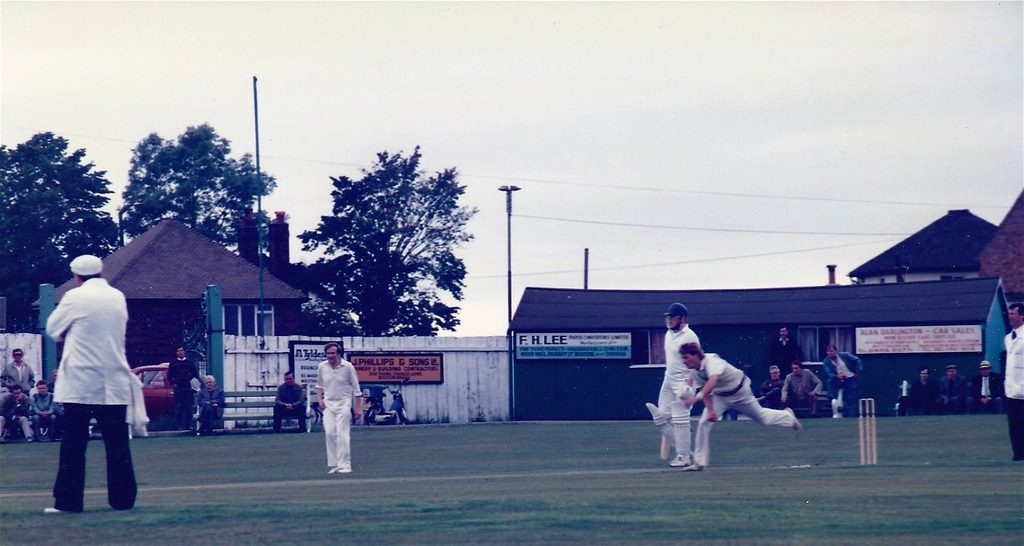 Mark Waugh bowls against Westhoughton (Credit: Mike Latham)
Mark Waugh bowls against Westhoughton (Credit: Mike Latham)
One of those ducks came at home against Egerton, caught and bowled second ball by Waugh, who took 5-44 to follow 79 out of 147 all out as the visitors won by 33 runs. Vengsarkar’s season would finish early when he jetted off for India’s tour of Sri Lanka, by which time he had scored 802 runs at 47.17 to finish fourth in the averages, helping Westhoughton finish third.
Waugh, meanwhile, got through a lot of hard yakka with the ball – “I bowled pretty much half the overs every week,” he recalls. “I was six foot when I got there and five feet four when I left” – and he finished with 59 wickets (the same number he took in Test cricket) at 17.88, with seventeen men above him in the averages, ten in the wicket charts. “It would have been double that amount if the keeper and slips could have caught the chances! I reckon I was too quick for them,” he quips. “It’s a pity he couldn’t field slip to himself,” says Ken Dickinson. “Everything that went in the air, he caught. It was incredible.”
Of course, when it comes to discussion of cricket’s greatest ever catchers, Waugh is usually in the thick of the conversation, and this higher-plane fielding was just one of the ways he embedded himself in the locals’ affections, to the extent that he soon became barrack-proof. Not that it would have bothered him anyway, recalls Sumner: “You’d always get barracking from the sides if you weren’t getting on with it. Mark would say, ‘Just ignore them, mate.’ I spent a lot of time batting with him and it’s no coincidence that was my best ever season in terms of runs [535]. He was so relaxed and it just rubbed off. It made you play better. Freer. There was no, ‘Okay, that was a shit shot, Dave’. It was, ‘Don’t worry about it’. Encouragement.”
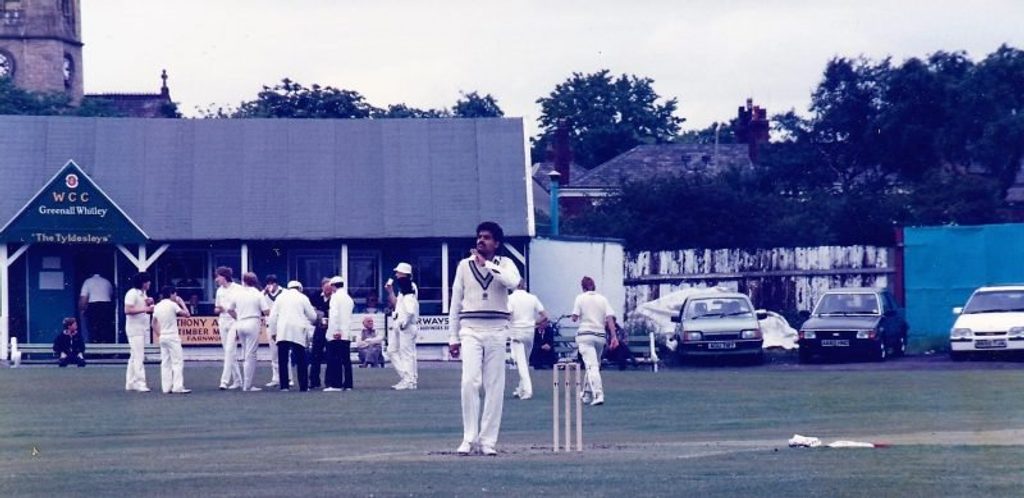 Westhoughton and India’s Dilip Vengsarkar at drinks (Credit: Mike Latham)
Westhoughton and India’s Dilip Vengsarkar at drinks (Credit: Mike Latham)
Indeed, Waugh was a generally laid-back presence around the club, attending practice twice a week, enjoying a romantic dalliance with one of Sumner’s wife’s nursing friends, and sticking around on match days to partake of the ritual libations, even being thrown a 20th birthday party on the first weekend in June. “Personally, I wasn’t a big drinker,” he says. “But you’ve got to fit in with the team, don’t you? There was a pretty big drinking culture. I would have drunk a little bit but it wasn’t my cup of tea. But you fit in with what’s going on and I certainly enjoyed it.”
“He’d have a drink,” adds Sumner, “although two or three pints as opposed to the six or seven others would have. He kept an appropriate distance, for want of a better phrase, from getting too involved in all that. I think he recognised he was being paid to do a sporting job and he had to be physically ready. He got the balance right.”
In August, ‘Junior’ made the 12-mile trip down to Old Trafford to watch the drawn Ashes Test, but otherwise didn’t venture too far from Bolton. “I was young and naïve and I hadn’t been away from home that much, so it was all a bit of an eye-opener. I was with Stephen to begin with, but you’re pretty nervous when you first get there – obviously, you don’t know anyone. They were a really friendly club, though, and made me feel welcome very quickly. Away from the cricket, I just hung around the house during the day, played a bit of golf, and went to the odd pub with other Australian cricketers who were playing around the leagues.”
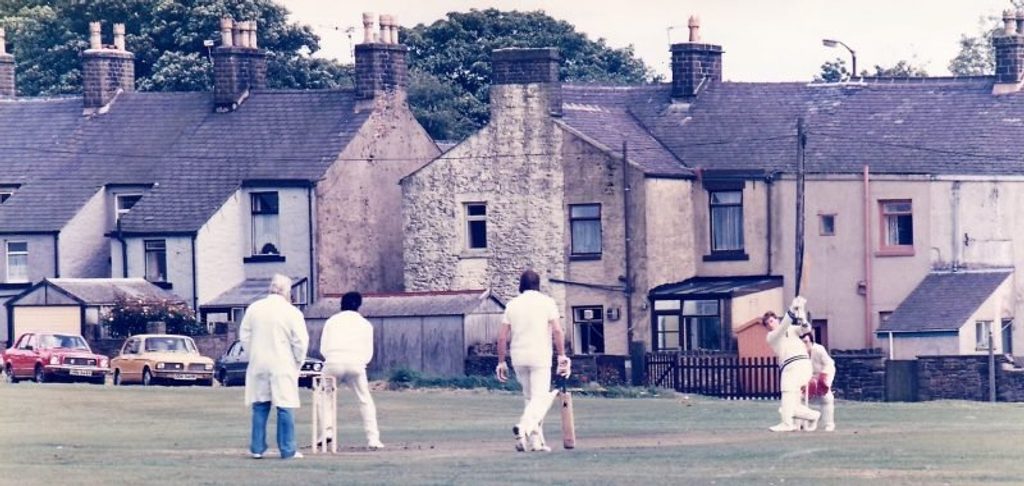 Mark Waugh launches Kearsley and India’s Mohinder Amarnath (Credit: Mike Latham)
Mark Waugh launches Kearsley and India’s Mohinder Amarnath (Credit: Mike Latham)
His compatriots in the Bolton League that year included Greg Shipperd at Heaton, another who went on the rebel tour that winter and who finished second in the BCL batting averages, with 898 runs at a tick under 50. And there was Rod Tucker – a fellow Sydneysider, but a year older than Waugh – who contributed 913 runs at 35.11 and 73 wickets at 13.01 for reigning champions Farnworth as their duel with cross-town rivals Farnworth Social Circle went to the very last ball of the season.
Unable to take the wicket they needed, it was instead the Social Circle team spearheaded by Bajan quick Roddy Estwick’s 116 wickets at 12.17 that landed its first BCL title, Farnworth settling for the Hamer Cup. Estwick had been sharing the new ball with Joel Garner and Wayne Daniel in the previous winter’s Shell Shield, and wasn’t necessarily someone the Egerton amateurs looked forward to facing, Waugh recalls, inadvertently alighting upon a key reason his teammates were weekend cricketers whereas he went on to be inducted into the Australian Cricket Hall of Fame: “I remember the other guys would panic about who they were going to play against the week after if it was a fast bowler, like Rod Estwick. I didn’t know much about him, but it was nothing to me. I loved it.”
Besides Vengsarkar, the other two pros in the league with Test caps were also Indians. Kearsley’s paid man was Mohinder Amarnath, Player of the Match in the World Cup final two years earlier, in which he sent down a spell of 7-0-12-3 at considerably less pace than Estwick. Sketchy details of the Egerton-Kearsley game have survived thanks to Mike Latham, then a 24-year-old accountant from nearby Leigh who later became Cricket Chairman of Cumberland CCC, Chairman of Leigh Centurions RLFC and a presenter with BBC Radio Lancashire. Back then, he was a cricket-loving ground-hopper with a camera, and he captured Waugh launching the Indian’s slow-mediums boundarywards en route to 67, Egerton’s non-barracking supporters sheltering from Lancashire’s July chill in their Sweeney-era cars.
READ: When Steve Waugh and Viv Richards faced off in the Lancashire League
The following Saturday, Tonge were the visitors to Longworth Road, their attack spearheaded by a 19-year-old Chetan Sharma who had already won four of his 23 Test caps. The previous year, Sharma had been overseas amateur at Morecambe, where Ravi Shastri was pro, and he too would leave early for that Sri Lanka tour, but not before his batting – later good enough for an ODI hundred against England – had contributed 695 runs at 46.33, finishing fifth in the averages. There were also 89 wickets at 11.75 in the main job – the third biggest bag at the fourth best average – to help his club to a fourth-place finish and the final qualification spot for the prestigious Lancashire Cup.
Having made a season’s best 140 not out at Tonge earlier in the season, Waugh may have fancied a few more. “It was his finest and undoubtedly best paced innings,” recalls club secretary Mike Hall. “He drove Sharma and the opposition to distraction with ultra-sound defence, perfect glides for ones and twos, and the occasional crisp strike to the boundary. It was a superb demonstration, from a 19 year old, of balancing risk and relentlessly wearing an experienced attack down. In fact, his batting ability shone through in every innings. He was always superbly organised at the crease, an impeccable judge of length, always in perfect position for brutal yet well placed cut shots and advancing down the wicket to the spinners.”
A wise old man of 20 by the time of the Tonge return, Waugh fell for just five as Sharma’s 7-43 hustled Egerton out for 147, McPhee making 66 before nicking behind to the 17-year-old Warren Hegg (not the only budding county gloveman to feature in the league that summer, as future Derbyshire stalwart Karl Krikken’s 15 catches and 18 stumpings for Astley Bridge saw the 16 year old become the first junior ever to win a senior BCL award). Tonge slipped to 55-4 in response, but Sharma’s unbeaten 56 shepherded them home.
For Waugh it was a minor blip in a hugely impressive canter past the thousand-run, dentistry-securing milestone, so much so that he attracted plenty of suitors among Egerton’s BCL rivals. “Other clubs were trying very hard to secure his services,” recalls Sumner. “Neville Neville, Gary and Phil’s dad, was really hunting him down for Greenmount.”
In the end, Waugh amassed 1359 runs – almost 300 more than the next best – at an average-topping 54.36, a phenomenal effort in a team that finished in tenth position, fifth from bottom. It was the third highest aggregate in BCL history, bettering the 1334 runs that future Test colleague Geoff Marsh had collected for Little Lever the previous year, although Marsh was himself some way behind the league-record 1535 runs churned out that year for champions Farnworth by Rod Bower, Waugh’s teammate at Bankstown. Bower’s record would in turn be eclipsed in 1989 by Astley Bridge’s Australian professional, who was also well known to Mark Waugh. That man was Dean Waugh, who certainly let his older brother know all about it, says ‘Junior’: “Yeah, he did mention he made more runs than me a few times. Dean could also drink a fair bit more than me, too.”
Waugh’s efforts may not have won him the BCL Professional of the Year prize – that went to Parvez Mir, the Pakistani all-rounder who played in the 1975 World Cup and who amassed 1068 runs for Walkden, including a league record 219 not out, to go with 74 wickets – but it did lead to a new and improved contract at Egerton for 1986. In the end, however, he was awarded the ACB’s Esso Scholarship, and spent the year with the MCC Young Cricketers, “pushing the covers on and off at Lord’s,” a ground he would adorn with an Ashes century 15 years later.
The future may have taken Waugh to the pinnacle of the game and 372 appearances for his country, but one small corner of Lancashire remained in his thoughts. “The Greenhalghs looked after me so well,” he says, “and I kept in touch with Pete and Iris for quite a few years when I was playing for Australia.” Nor did his former teammates slip entirely from his mind. “I bumped into him at a Lashings game at Farnworth,” recalls Ian Taylor. “I’d gone over to the dressing room: ‘Alright Taddy, how are you, mate?’ It was as though he’d never been away. That summed him up. He wanted to let people know he knew who I was.”
‘Junior’ also popped in at Heaton with Ronnie Irani when Essex were playing at Old Trafford, while Steve Dickinson remembers Waugh returning to Longworth Road bearing swag: “Even when he played at Essex he would come up to the club occasionally in his sponsored Vauxhall Carlton full of Slazenger cricket gear and give it away to everyone. He used to let people know when he was coming up and people would go and get bats and gloves and all sorts. I used to feel a bit let down because I was a left-handed batter!”
Over the years that followed Waugh’s run-laden season at Egerton, his diehard England-supporting former colleagues would have experienced acute cognitive dissonance, hoping against hope for an England Ashes win at the same time as wanting their old Australian mate to make some runs – Mark, not Steve; he could fail – and perhaps wondering whether that distant summer had played a small part in it all. “Looking back at the experience of being the overseas professional,” says Waugh, “there was always that pressure for you to perform every week. I did pretty well – probably better than they expected to be honest – and I have very fond memories of it. In a lot of ways, it was a really good grounding for future years.”
Even if it’s a stretch to claim that the major components of Mark Waugh’s distinctively elegant game were shaped in Bolton League cricket, it’s undeniably true that, thanks to his prodigious batting feats, a couple of his teeth certainly were.








